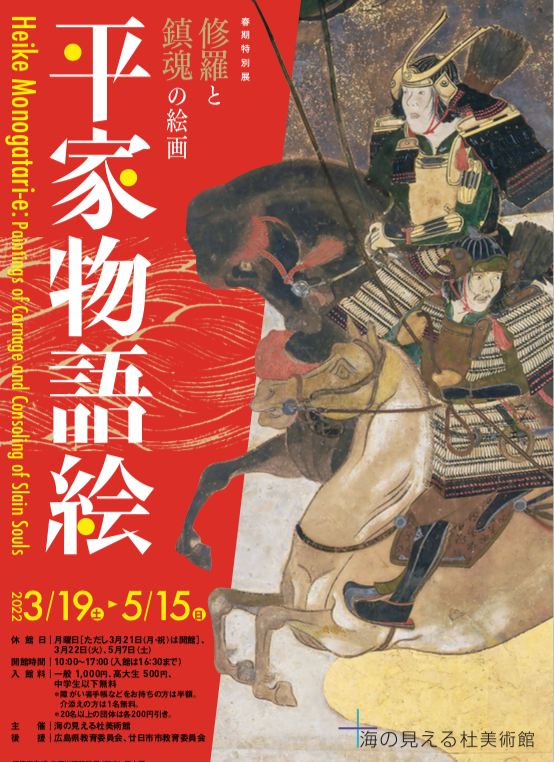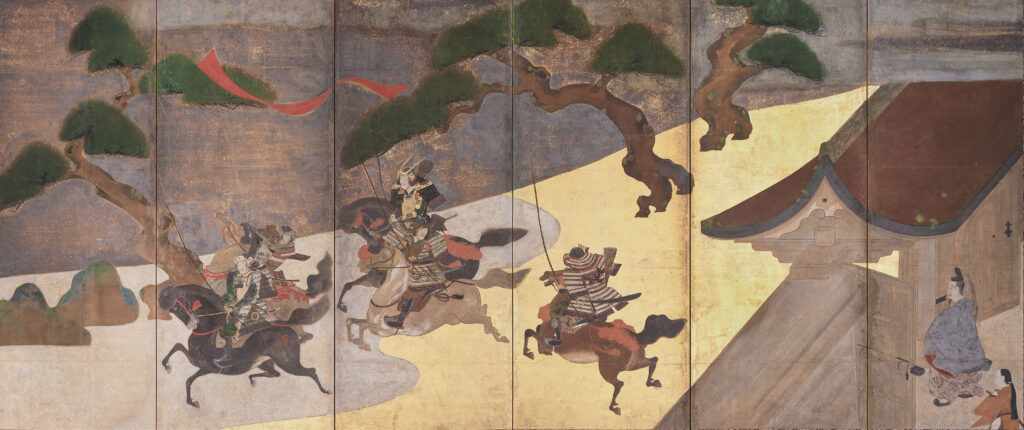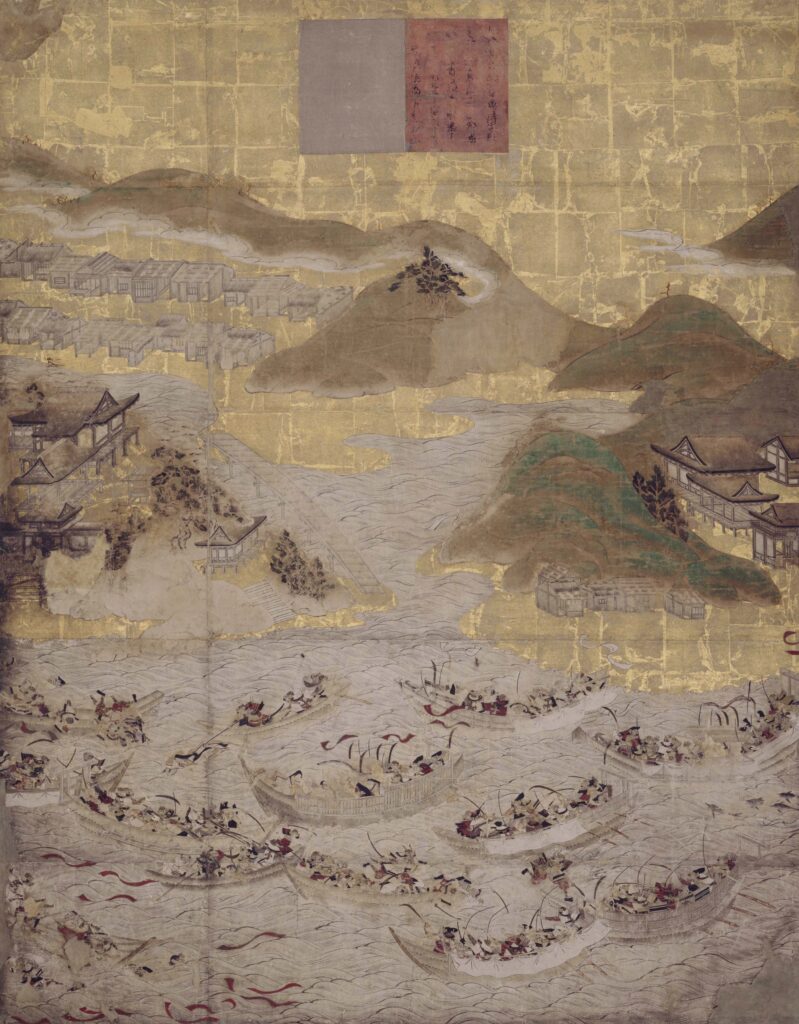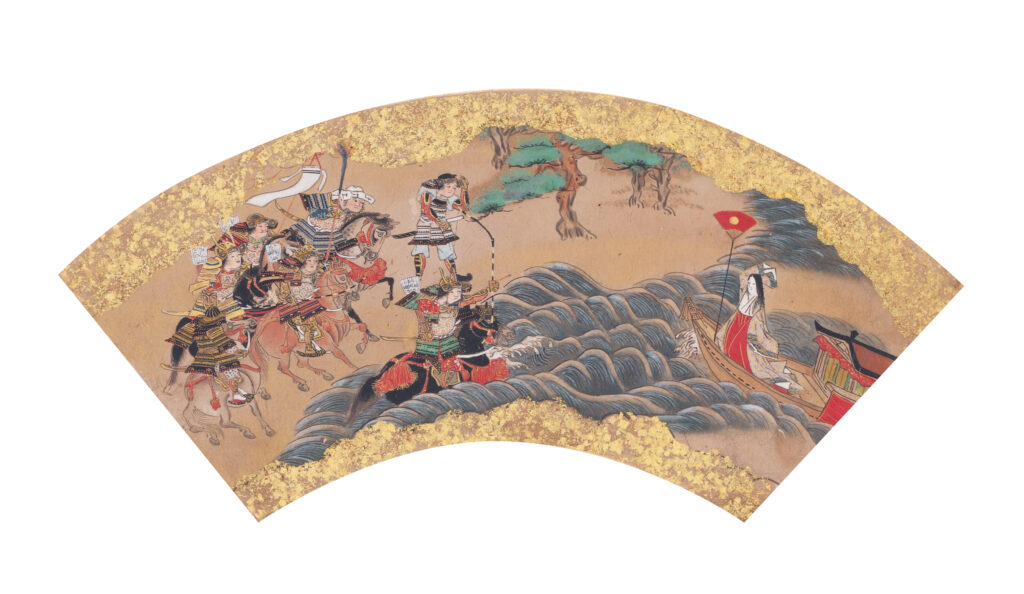Exhibitions
Heike Monogatari-e: Paintings of Carnage and Consoling of Slain Souls

Heike Monogatari (The Tale of the Heike) recounts the rise and fall of the Taira clan. Though a work of literature, it has long been represented in paintings too. This exhibition features a variety of illustrated scrolls, books, fans, folding screens and sliding doors, from famous medieval works to those used as educational tools by warrior families during the Edo period (1603–1868). Discussions of Heike Monogatari-e paintings tend to focus on the ‘carnage’ of the Genpei War, but works like The Emperor’s Visit to Ohara also portray the subsequent ‘consolation’ and ‘salvation’ of the Taira clan. These themes resonated down the ages, particularly during the war-torn periods that frequently occurred until the modern age, with Heike Monogatari-e constantly being revitalized. This exhibition explores the timeless traditions of Heike Monogatari-e through several representative works.

General Information
Hours: 10:00-17:00 (Last entry: 16:30)
Closed: Monday (except March 21st), and March 22nd, May 7th
Admission: General admission: 1,000 yen, High school/university students: 500 yen, Junior high school students and younger: Free
*Admission is half price for people with disability certificates, etc. One accompany person is admitted free of charge.
*Groups of 20 or over will receive a discount of 200 yen per person.
Venue: Umi-Mori Art Museum (10701 Kamegaoka, Ohno, Hatsukaichi, Hiroshima)
With the support of: Hiroshima Board of Education and Hatsukaichi City Board of Education
Chapter One Heike-e: A World in the Palm of the Hand
Heike Monogatari (The Tale of the Heike) is said to date back to the early 13th century. The story was passed down orally by biwa lute-playing minstrels and also enjoyed as a work of literature. Artists soon began painting scenes from Heike Monogatari, as evidenced by the Kamakura-period Illustrated Tale of the Heiji Civil War (1192–1333), a segment of which is housed in Tokyo National Museum. Sadly, few of these Kamakura-period ‘Heike-e’ (‘Heike paintings’) are still with us. Records from the Muromachi period (1392–1573) recount how Heike Monogatari illustrated scrolls were cherished by emperors and military leaders, though extant examples are rare. This chapter introduces some of these rare Muromachi-period illustrated scrolls. Each one is around 15 inches high, small enough to fit in the palm of the hand. It is believed Hakubyo Heike Monogatari (The Tale of the Heike in Line Drawings) (No. 2) once portrayed Heike Monogatari in its entirety. Heike Kindachi Soshi (Illustrated Scroll of Nobles of the Taira Clan) (No. 1) is a derivative work produced during medieval times. People back then were still enthralled by Heike Monogatari and they would paint their favourite characters in popular scenes. These also included charismatic portraits of Taira clan members alongside the usual depictions of warriors in the heat of battle. All this reveals how Heike-e were enjoyed by a select group of high-ranking people during the Muromachi period.


Chapter Two Heike-e: Carnage and Consolation
With the Minamoto clan fast approaching, the Taira clan fled the capital Kyoto with the Emperor Antoku. They then spent around half a year moving back and forth across the Seto Inland Sea. After several battles at sites like Ichi-no-tani and Yashima, the Taira were finally vanquished in the waters of Dan-no-ura. During the Edo period (1603–1868), folding screens depicting these battles were very popular among the warrior class. They portrayed feats of martial derring-do and famous tragic scenes. However, earlier ‘Heike-e’ (‘Heike paintings’) also featured other scenes besides battles. After Emperor Antoku drowned at Dan-no-ura, his mother Kenreimon-in was left all alone. She retreated into seclusion at Ohara and prayed for the repose of her family’s souls. When Emperor Go-shirakawa visited Ohara one day, Kenreimon-in spoke to him about the fate of the Taira using the metaphor of the six realms of reincarnation. Though once extremely prosperous, the clan was later wiped out in the ‘carnage’ of frightful fighting. It was the task of those left behind to pray for the souls of the dead. Maybe the act of painting their story was also undertaken as a form of ‘consolation.’ Amida-ji Temple (present-day Akama Shrine) was built on the orders of Emperor Go-shirakawa and dedicated to Emperor Antoku. The Illustrated Biography of Emperor Antoku (No. 10) was later painted in the temple’s hall. The Emperor’s visit to Ohara was also a popular painting theme from the Momoyama period to the start of the Edo period. This coincided with Japan’s Warring States period, so perhaps people imbued these works with prayers for family members lost in the fighting.
Battles and Carnage
Heike Monogatari features many famous battle scenes still familiar to us today. These include Taira no Atsumori and Kumagai Naozane squaring off at the battle of Ichi-no-tani, for instance, or Nasu no Yoichi hitting a fan with an arrow at the battle of Yashima. Paintings of these scenes exalt the bravery of the warriors while also portraying the tragic fate of the Taira clan. The road to the Taira’s downfall is mapped out in these paintings of the carnage of war.
Consolation and Salvation
Not only did the downfall of the Taira clan plunge its allies into despair, it also made their enemies fearful of vengeful spirits. The consolation of the souls of the Taira thus became a pressing matter for allies and foes alike. The Emperor’s Visit to Ohara and other works themed on Heike Monogatari were still being produced in volume at the start of the Edo period. Perhaps the victors of the brutal Warring States period also saw these paintings as a way to console the souls of the fallen.
To the Shores of Itsukushima
Since his time as governor of Aki Province, Taira no Kiyomori venerated Itsukushima and he restored a waterfront shrine similar to modern-day Itsukushima Shrine. One of the deities worshipped by Kiyomori was Itsukushima’s Dragon King. During the Kamakura period, a legend grew that Emperor Antoku had actually been the reincarnation the Dragon King’s daughter, with the young emperor returning to the seas after sinking beneath the waves at Dan-no-ura. His destination may have been the seas of Itsukushima. To this day, over 900 years since the downfall of the Taira, Itsukushima Shrine continues to testify to the past glories of the once-mighty clan.





Chapter Three The Evolution of Heike-e
Heike Monogatari inherited a clear political meaning during the Edo period. The ruling Tokugawa shogunal clan claimed to be descended from the Minamoto clan. The Minamoto victory had ushered in an age of military rule, with tales of their victory now used to exemplify how men and women from warrior families should conduct themselves. Heike Monogatari served this purpose, as did Hogen Monogatari (The Tale of Hogen) and Heiji Monogatari (The Tale of Heiji), two tales of earlier events. These works became the subject of long picture book series or illustrated scrolls over ten volumes long. These were collected by prosperous warrior families, including the Tokugawa and Matsudaira clans. Characterized by brightly-colored paintings and lavishly-decorated paper and covers, these works became a luxurious part of the household furnishings of feudal lords.
During medieval times, individual episodes from Heike Monogatari were incorporated into the literary and performing arts. This led to creation of numerous works inspired by the tale. These included ‘otogi zoshi,’ a type of illustrated short story popular during the Muromachi period. Examples from the performing arts include Noh and Kowaka dance from medieval times and jōruri (storytelling accompanied by music) and kabuki from early modern times. The paintings that accompanied these works can also be classified as ‘Heike-e’ in a wider sense. These allowed people to enjoy Heike Monogatari not only through the written word but also through a rich variety of images.
Heike-e and the Cultivation of the Warrior Class
As the Warring States period ended and the Edo period dawned, a new group of non-official ‘town painters’ also began producing sumptuous sets of Heike-e. These included picture books, illustrated scrolls and albums of famous scenes painted on fan-shaped paper. During the Edo period, members of the warrior class were expected to learn about Heike Monogatari. Paintings probably facilitated this process and made it more enjoyable.
Heike-e in Literature and the Performing Arts
During the Muromachi period, many captivating episodes from Heike Monogatari were incorporated into performing arts like Noh and Kowaka dance. In the run up to the Battle of Okehazama, the warlord Oda Nobunaga performed a dance and sang about how “Human live lasts only 50 years…” This passage was taken from a Kowaka dance themed on The Death of Atsumori from volume nine of Heike Monogatari. These performing arts were also represented and enjoyed in pictorial form.



